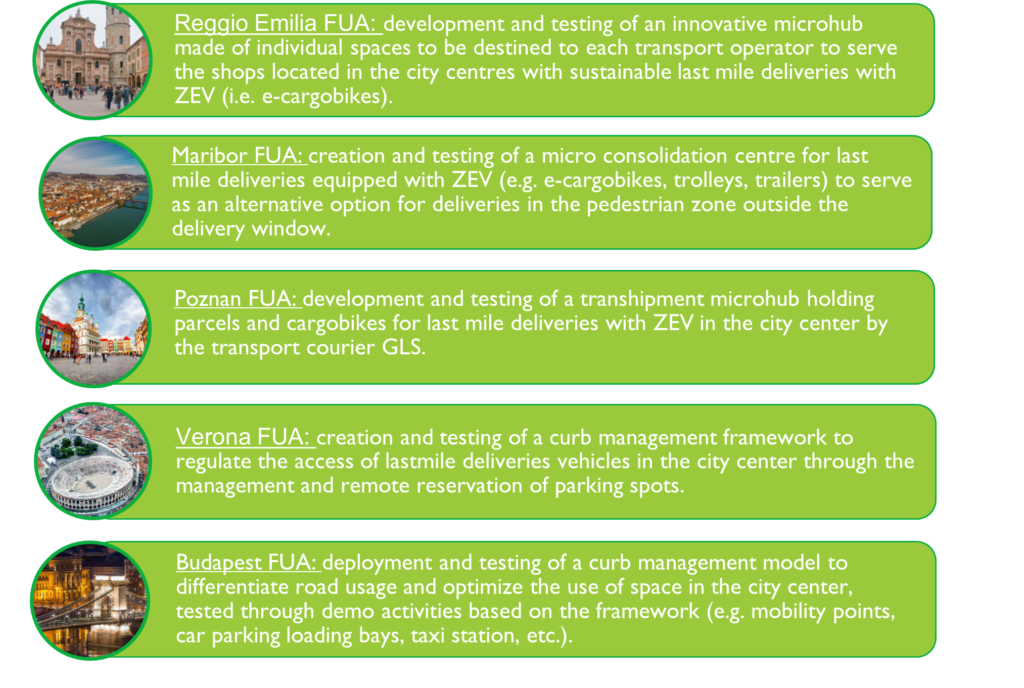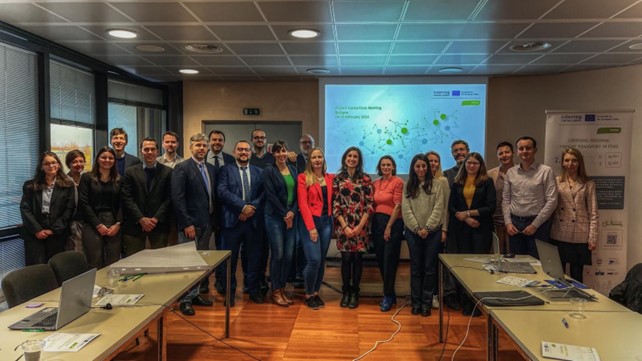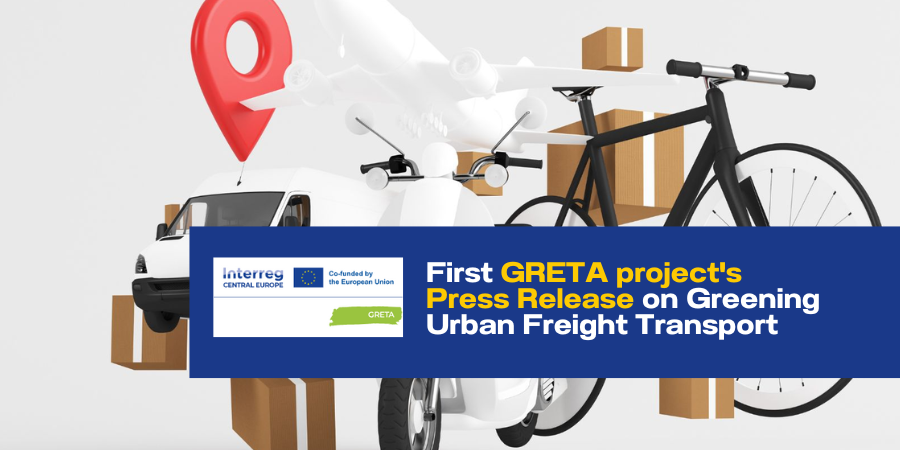Why a project on greening urban freight transport?
In recent years freight delivery was worsened by the e-commerce expansion and Covid-19, resulting in increased emissions, noise and congestion of limited public space, loss of time and resources, and challenges related to road safety, reducing life’s quality and even impacting economic performance.
Co-financed by the Interreg Central Europe Programme with a budget of 2,71 M €, the GRETA partnership aims to overcome these challenges with the objective to decarbonize the last mile delivery in Functional Urban Areas (FUAs). This is going to be achieved by implementing sustainable and innovative solutions in CE FUAs that can be readily scaled up and transferred to reduce the number of delivery vehicles on the road make our cities cleaner, quieter, and more liveable.

The importance of a strategic planning to tackle the mobility issues in Functional Urban Areas
Functional Urban Areas (FUAs) are geographic areas characterized by strong economic, social, and functional interconnections, involving cities and their surrounding hinterlands, often beyond the administrative boundaries of a single municipality. They serve as important hubs with high population density, mixed land use, and a high level of commuting. This makes them particularly challenging to plan for mobility, as it requires coordination between multiple municipalities and transportation authorities.
In the framework of the GRETA project, a FUA consists of a densely inhabited city (a core area) and a less densely populated commuting zone whose labour market is highly integrated with the city.
More in particular, GRETA FUAs are located in:
- Budapest (Hungary)
- Maribor (Slovenia)
- Poznan (Poland)
- Reggio Emilia (Italy)
- Verona (Italy)

For each of these, several parameters and KPIs have been collected through a dedicated deliverable (D1.2.2 Territorial needs and gaps carried out in all the GRETA FUAs) to understand the needs, gaps and initiatives implemented by FUAs in freight transport, resulting in a table that resumes the main objectives and challenges for each FUA, also on the basis of each Sustainable Urban Mobility Plan (SUMP).
GRETA FUAs’ challenges and envisaged solutions
GRETA FUAs are facing different challenges in reaching their objectives regarding urban mobility. But there are two specific challenges that all of them have in common:
- high car dependency (modal split), and
- emissions from transport (pollution and noise emissions).
The solutions to these problems can be summarized into following categories:
- improving network connections,
- modernisation of public transport systems and fleets (including better user experiences),
- Park and Ride systems and other parking solutions,
- bicycle networks expansions,
- low emission zones, pedestrian zones, low speed zones,
- infrastructure investments,
- smart solutions and traffic management,
- efficient governance, community engagement, participation,
- education and awareness raising, aimed at encouraging the use of sustainable vehicles in urban areas as well as a more active mobility.
Each FUA targets a different mix of interventions from the list above. In general, the aims of the FUAs are quite similar, which is not unexpected. It is also striking that urban mobility is not specifically focused on freight transport and logistics in urban centres, as more attention is paid to the mobility of people, considering that all FUAs stated that freight transport and logistics activities definitely contribute to congestion as well as air and noise pollution.
An overview of the main measures that were listed by FUAs in relation to transport investments – categorized by timeframe – is presented in the table below.
| Investments finished in the last 3 years | Investments currently in progress | Investments planned |
| Transport infrastructure renovation/construction Public transport investments (infrastructure, rolling stock) Restricted zones Mobility applications Bike sharing service E-vehicles in public transport Park&Ride parking SUMP Public awareness | Transport infrastructure renovation/construction Public transport investments (infrastructure, rolling stock) Micro mobility network Micro consolidation centres SULP, metropolitan SUMP, FUA public transport and bicycle plan Investment into cycling (bicycle lanes/highways, stations, racks, incentives, bike sharing) | Parking regulations, parking plan Public transport investments (infrastructure, rolling stock) Universal parcel locker network Micro consolidation centres Micro mobility network Restricted zones (emissions) Safety (speed monitoring) |
As underlined by the table above, topic measures range from the investments in transport and cycling infrastructures (including sharing services) to mobility planning (SUMP), safety and parking facilities, especially park and ride solutions. Moreover, other measures address freight transport in particular, and mainly concern the implementation of parcel lockers and micro consolidation centres. In any case, more details on the measures implemented in each specific FUA will be available in the ongoing deliverable D.1.2.2 Territorial needs and gaps carried out in all the GRETA FUAs mentioned above.
It’s important to note that none of the investments implemented in the past three years have been directly focused on freight transport or logistics, although the listed measures do have an indirect impact on freight transport. However, there has been improvement in the current ongoing investments, as they include measures specifically targeting freight transport and logistics. This is also the case for future investments, which will incorporate innovative interventions such as parcel lockers and micro consolidation centres for freight transport.
Despite their broader territorial scope, the measures implemented and planned by FUAs do have an impact on the mobility planning carried out by local authorities, who play a crucial role in addressing the specific mobility needs of the local community.
The interaction between Functional Urban Areas (FUAs) and local authorities has the potential to foster regional cooperation, allowing for the sharing of relevant expertise and the development of integrated mobility plans for both people and freight transportation ensuring a coordinated approach to addressing mobility challenges at a broader scope, aligning local transportation strategies with the larger regional objectives identified by FUAs.
Simultaneously, this enhanced cooperation can facilitate the leveraging of funding opportunities, as local authorities can partner with FUAs to gain a better understanding of mobility challenges and priorities. By working together, they can create sustainable and efficient transportation systems that benefit urban communities and their surrounding regions.
Furthermore, FUAs’ interventions also impact local mobility planning by altering the starting conditions, gaps, and priorities of the local transportation system. For example, investments in public transport lines outside urban areas, as well as the promotion of intermodality through dedicated park-and-ride facilities and extended service hours, have the potential to facilitate commuting for citizens. This may lead individuals to shift from private cars to more sustainable modes of travel, consequently reducing road congestion and pollution emissions. Similarly, FUAs’ investments in universal parcel locker networks and micro-consolidation centers can aggregate freight deliveries, reducing the number of heavy-duty vehicles within urban areas and positively impacting road safety.
Therefore, FUAs’ interventions have a significant influence on local mobility planning by promoting a more holistic and integrated approach, fostering collaboration, sharing knowledge, and leveraging funding opportunities. The ultimate goal is to create sustainable and efficient transportation systems that benefit both urban communities and their surrounding regions.
GRETA accelerates towards a greener urban freight landscape: key takeaways from first in person project meeting
Bologna, Italy – February 14-15, 2024
The 11 partners of the GRETA project – representing key stakeholders in the field – have convened for a crucial two-day meeting in Bologna, organized by the lead partner ITL (Institute for Transport and Logistics Foundation). This gathering, which marked a significant milestone, proved to be a springboard for progress, as attendees delved into project administrative and financial updates on WPs and Activities, sharing insights from ongoing pilot projects, and collaboratively strategizing for the upcoming initiatives.
Unveiling Progress through Open Dialogue
Detailed presentations shed light on advancements in the technical activities comprised in WP 1 (Understanding and analysis), WP 2 (Sustainable urban freight and logistics measures) and WP 3 (Policy support towards a green urban freight transition in FUAs), as well as for communication activities embedded in each WP.
Pilot actions spotlight: Representatives from the 5 FUAs implementing a pilot action each – namely Reggio Emilia, Maribor, Poznan, Verona and Budapest – offered valuable insights into their unique pilot projects, showcasing their specific context, needs, methodology and approach to develop an innovative pilot activity to achieve sustainable freight distribution in urban areas. The following figure presents the main concept of the five pilot activities implemented by the GRETA FUAs.

Collective learning and planning: Two interactive sessions workshop fostered a spirit of collaboration, offering an open platform to brainstorm and share insights for the joint development of upcoming tasks and activities.
o The Peer review workshop allowed partners to mutually elaborate on each of the 5 pilot actions presented, asking questions and sharing knowledge in order to consolidate synergies and ensure a transnational approach to foster shared solutions for common challenges.
o The Freight Quality Partnership workshop offered the opportunity to jointly reflect on how to set up and run the FQP, including selection criteria and engagement strategies, as well as needs and capabilities of each stakeholders’ category.
Witnessing sustainable innovation first-hand: Participants embarked on a site visit to the microhub in Bologna for B2B deliveries, implemented in the framework of the URBANE project (Horizon), thus gaining firsthand experience with tangible sustainable solutions in action. Specifically, it involved a set of lockers of various size that are used by couriers and transport operators to drop off small parcels that are then collected to be delivered in the city center through a small and electric cargo vehicle, thus producing zero polluting emissions.
Building momentum for a greener tomorrow
The GRETA Consortium was able to foster a solid foundation, emerging from the meeting invigorated and equipped with a clear direction for the future. The open exchange of ideas, collaborative spirit, and insightful discussions served as a catalyst for moving forward, paving the way for a more sustainable urban freight landscape, especially in functional urban areas of Central Europe.

